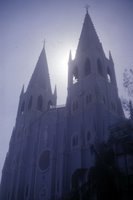 When we say Quiapo, the first things that come to mind are images of the Black Nazarene, the multitude of people that makes an annual walk of fate with the image during the 9th of January processions, and the Basilica Minore of the Black Nazarene (Quiapo Church) with the myriad of hawkers and stalls, herbal medicine and anting-anting vendors and fortune tellers abundant in adjacent Plaza Miranda. But unknown to many, Quiapo is home to an even rarer gem, another basilica minore in fact in Plaza del Carmen. This is the Basilica Minore de San Sebastian, the first all-steel church in the Philippines and in Asia, and the second in the world.I was looking through my archive of photos which I took long before I started to blog. In fact, several were taken even before I enjoyed internet access. And among them were photos of the San Sebastian Church which I shot way back in high school during an alternative class day exposure trip to old Manila. I realized that my photo archive was a wealth of untapped material and not featuring these places I've been to and documented would be a waste.
When we say Quiapo, the first things that come to mind are images of the Black Nazarene, the multitude of people that makes an annual walk of fate with the image during the 9th of January processions, and the Basilica Minore of the Black Nazarene (Quiapo Church) with the myriad of hawkers and stalls, herbal medicine and anting-anting vendors and fortune tellers abundant in adjacent Plaza Miranda. But unknown to many, Quiapo is home to an even rarer gem, another basilica minore in fact in Plaza del Carmen. This is the Basilica Minore de San Sebastian, the first all-steel church in the Philippines and in Asia, and the second in the world.I was looking through my archive of photos which I took long before I started to blog. In fact, several were taken even before I enjoyed internet access. And among them were photos of the San Sebastian Church which I shot way back in high school during an alternative class day exposure trip to old Manila. I realized that my photo archive was a wealth of untapped material and not featuring these places I've been to and documented would be a waste.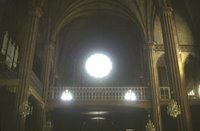 It was sometime in 1995 or 1996, my third year in the Ateneo and we were the beneficiaries of the first-ever alternative class day called KLIK... Klaseng Ibang Klase. We had a choice of selecting three talks throughout the day or pick a day trip for a fee. And I chose this trip to old Manila, with social studies teacher Estela Banasihan and Fr. Mac Reyes, S.J. as tour guides. I consider this trip my introduction to Philippine architectural heritage. The trip tickled my fancy in fact that the next year, I chose another heritage tour during KLIK, a church tour in Rizal and Laguna.
It was sometime in 1995 or 1996, my third year in the Ateneo and we were the beneficiaries of the first-ever alternative class day called KLIK... Klaseng Ibang Klase. We had a choice of selecting three talks throughout the day or pick a day trip for a fee. And I chose this trip to old Manila, with social studies teacher Estela Banasihan and Fr. Mac Reyes, S.J. as tour guides. I consider this trip my introduction to Philippine architectural heritage. The trip tickled my fancy in fact that the next year, I chose another heritage tour during KLIK, a church tour in Rizal and Laguna.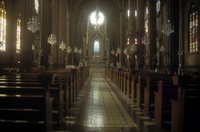 One of our stops was the San Sebastian Church. And to tell you honestly, I was not ready for what I was going to see. Upon entering, this young high school student never realized that such a treasure existed in the country. And I remember distinctly Fr. Mac knocking on the walls of the church to prove to us that the structure was indeed made of steel!
One of our stops was the San Sebastian Church. And to tell you honestly, I was not ready for what I was going to see. Upon entering, this young high school student never realized that such a treasure existed in the country. And I remember distinctly Fr. Mac knocking on the walls of the church to prove to us that the structure was indeed made of steel!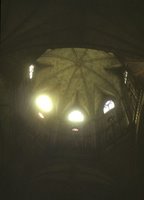 I would later find out that the Philippines used to have much more than that. But the very structures which made us the Pearl of the Orient, architectural treasures that spanned hundreds of years, were flattened by the American Army in a few days during the liberation of Manila.The structure was prefabricated in Belgium, dismantled and shipped back to the Philippines. It was said that after three earthquakes that leveled the earlier San Sebastian churches, the Recollects decided to use an unconventional material to build an earthquake proof church. Which explains why the structure is entirely made of steel. But nothing is decay-free and we all know that the biggest enemy of steel is iron oxide, more commonly known as rust!
I would later find out that the Philippines used to have much more than that. But the very structures which made us the Pearl of the Orient, architectural treasures that spanned hundreds of years, were flattened by the American Army in a few days during the liberation of Manila.The structure was prefabricated in Belgium, dismantled and shipped back to the Philippines. It was said that after three earthquakes that leveled the earlier San Sebastian churches, the Recollects decided to use an unconventional material to build an earthquake proof church. Which explains why the structure is entirely made of steel. But nothing is decay-free and we all know that the biggest enemy of steel is iron oxide, more commonly known as rust!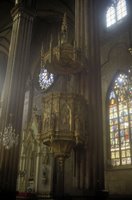
 This is why the World Monuments Fund (WMF) included the structure in the List of 100 Most Endangered Sites in 1998. Inclusion in the World Monuments Watch entitles the structure to grants for restoration. And I find it stupid that the custodians of the church rejected the $25,000 grant given by the WMF simply because of jurisdiction issues with the Philippine government. As a result, the Philippines had to do the embarrassing act of returning the $25,000 to the WMF!It reminds me of the lack of appreciation for heritage rampant in the Catholic Church. In fact, priests are the number one destroyers of Philippine church heritage. They sell off antiques to raise money, lured by heavenly sums offered by sneaky antique collectors. A big number renovate their heritage churches according to their whims and caprices simply to leave their mark, damaging or even eradicating centuries of work in a few months. Right at this very moment, the hard-headed parish priest in Paoay, a UNESCO World Heritage site, is plastering the walls of the church with cement! When will this carnage to heritage churches end? Will the CBCP please put its foot down and end this wanton disregard for Philippine architectural heritage. In Mexico, after their own revolution against Spain, all church property became state property which is why all their churches are untouched and well-preserved. Sometimes, I wished that happened in the Philippines as well.Back to San Sebastian, rumor has it that the metal structure of the San Sebastian Church was designed by Alexander Gustave Eiffel himself. But I have yet to hear the official word from the NHI or NCCA.Metro Manila is host to more heritage churches or what's left of them. You can check out the Visita Iglesia Manila Project for a complete listing.
This is why the World Monuments Fund (WMF) included the structure in the List of 100 Most Endangered Sites in 1998. Inclusion in the World Monuments Watch entitles the structure to grants for restoration. And I find it stupid that the custodians of the church rejected the $25,000 grant given by the WMF simply because of jurisdiction issues with the Philippine government. As a result, the Philippines had to do the embarrassing act of returning the $25,000 to the WMF!It reminds me of the lack of appreciation for heritage rampant in the Catholic Church. In fact, priests are the number one destroyers of Philippine church heritage. They sell off antiques to raise money, lured by heavenly sums offered by sneaky antique collectors. A big number renovate their heritage churches according to their whims and caprices simply to leave their mark, damaging or even eradicating centuries of work in a few months. Right at this very moment, the hard-headed parish priest in Paoay, a UNESCO World Heritage site, is plastering the walls of the church with cement! When will this carnage to heritage churches end? Will the CBCP please put its foot down and end this wanton disregard for Philippine architectural heritage. In Mexico, after their own revolution against Spain, all church property became state property which is why all their churches are untouched and well-preserved. Sometimes, I wished that happened in the Philippines as well.Back to San Sebastian, rumor has it that the metal structure of the San Sebastian Church was designed by Alexander Gustave Eiffel himself. But I have yet to hear the official word from the NHI or NCCA.Metro Manila is host to more heritage churches or what's left of them. You can check out the Visita Iglesia Manila Project for a complete listing.
After that blunder by some local government officials from Batanes last year, we will have to wait again another year until a new Philippine site is listed in the UNESCO World Heritage list. They thought they could handle the inscription process on their own, purposely left out all the experts who prepared the bid of the Batanes Protected Landscapes and Seascapes, and got a painful rejection from UNESCO. What were they thinking? It turns out, the papers were simply not in order and had they included the heritage people involved in documenting Batanes, it would have been listed with UNESCO last year. Sad part is there is a limit to the number of sites listed per country per round. And because of Batanes' deferment, the slot meant for another Philippine site in the next round will be used by Batanes. Oh well!  I chanced upon a list of proposed UNESCO World Heritage sites. I've always known that Batanes is the next Philippine site for inscription in the prestigious list. There are more candidates on the shortlist and it may take several years before we get them in the UNESCO list. Sad to say, I've only visited one of the proposed sites, the San Sebastian Church which I will talk about in my next entry. But I wonder which churches will be included in the listing Jesuit Churches of the Philippines and and which forts in Spanish Colonial Fortifications of the Philippines since I may have seen some of them. Let me try to ask Fr. Rene Javellana since those groupings are actually books which he had written, namely "Wood and Stone for God's Greater Glory: Jesuit Art and Architecture in the Philippines" and "Fortress of Empire: Spanish Colonial Fortifications of the Philippines 1565-1898."
I chanced upon a list of proposed UNESCO World Heritage sites. I've always known that Batanes is the next Philippine site for inscription in the prestigious list. There are more candidates on the shortlist and it may take several years before we get them in the UNESCO list. Sad to say, I've only visited one of the proposed sites, the San Sebastian Church which I will talk about in my next entry. But I wonder which churches will be included in the listing Jesuit Churches of the Philippines and and which forts in Spanish Colonial Fortifications of the Philippines since I may have seen some of them. Let me try to ask Fr. Rene Javellana since those groupings are actually books which he had written, namely "Wood and Stone for God's Greater Glory: Jesuit Art and Architecture in the Philippines" and "Fortress of Empire: Spanish Colonial Fortifications of the Philippines 1565-1898."  Another proposed site are the Angono Petroglyphs were declared a national cultural treasure under Presidential Decree No. 260 of President Marcos in 1973. Together with the San Sebastian Church, both sites were included in the biennial World Monuments Watch: List of 100 Most Endangered Sites in 1996 and 1998 respectively. Most of the sites are featured in the book "The National Parks and Other Wild Places of the Philippines," which came out during the term of Gemma Cruz-Araneta as DOT Secretary. These are Batanes, Mt. Pulag National Park (at 9, 586 feet, Mt. Pulag is the highest peak in Luzon) and Northern Sierra Madre Natural Park in Luzon, the El Nido Marine Reserve, and the Agusan Marsh Wildlife Sanctuary in Mindanao which is one of four Philippine sites listed in the RAMSAR List of Wetlands of International Importance. The tenth site listed is the Turtle Islands Wildlife Sanctuary in Tawi-tawi. Composed of six islands in the Sulu Sea, the marine park is part of a transnational protected area together with Malaysia that is believed to be the only remaining nesting islands for Green Turtles in the ASEAN region.
Another proposed site are the Angono Petroglyphs were declared a national cultural treasure under Presidential Decree No. 260 of President Marcos in 1973. Together with the San Sebastian Church, both sites were included in the biennial World Monuments Watch: List of 100 Most Endangered Sites in 1996 and 1998 respectively. Most of the sites are featured in the book "The National Parks and Other Wild Places of the Philippines," which came out during the term of Gemma Cruz-Araneta as DOT Secretary. These are Batanes, Mt. Pulag National Park (at 9, 586 feet, Mt. Pulag is the highest peak in Luzon) and Northern Sierra Madre Natural Park in Luzon, the El Nido Marine Reserve, and the Agusan Marsh Wildlife Sanctuary in Mindanao which is one of four Philippine sites listed in the RAMSAR List of Wetlands of International Importance. The tenth site listed is the Turtle Islands Wildlife Sanctuary in Tawi-tawi. Composed of six islands in the Sulu Sea, the marine park is part of a transnational protected area together with Malaysia that is believed to be the only remaining nesting islands for Green Turtles in the ASEAN region.  Another proposed listing which I've been hearing about but not found in the tentative list are the Spanish Lighthouses of the Philippines, many of which are featured in the book of Arch. Manolo Noche entitled "Lonely Sentinels of the Sea: The Spanish Colonial Lighthouses in the Philippines." I guess the Philippines has a long way to go in raising the consciousness of its citizens on the importance of preserving heritage. But what can we expect from a Third World country which obviously has more pressing needs? That is why heritage conservationists have to be vigilant in protecting what is left of our built heritage resources. Because when the time comes that Filipinos are mature enough to realize why heritage needs to be protected, there might not be much of it left to appreciate.
Another proposed listing which I've been hearing about but not found in the tentative list are the Spanish Lighthouses of the Philippines, many of which are featured in the book of Arch. Manolo Noche entitled "Lonely Sentinels of the Sea: The Spanish Colonial Lighthouses in the Philippines." I guess the Philippines has a long way to go in raising the consciousness of its citizens on the importance of preserving heritage. But what can we expect from a Third World country which obviously has more pressing needs? That is why heritage conservationists have to be vigilant in protecting what is left of our built heritage resources. Because when the time comes that Filipinos are mature enough to realize why heritage needs to be protected, there might not be much of it left to appreciate.
I'll definitely be blogging quite more often now that I'm done with my MBA. I just came from a business trip to Pangasinan last Sunday. While checking out some properties in Rosales, my brod Ryan Tan mentioned to me that Li-an Ramos (my kabarkada, blockmate in the UP School of Economics and co-dormer at the Kalayaan Residence Hall way back in 1997) was crowned Binibining Pilipinas Universe 2006! Wow! It seemed like only yesterday when we were freshmen at UP. Since we had the same class schedule, and stayed at the same dorm, we often walked to and from the dorm together. Good luck in the Miss Universe pageant in Vanuatu! I'm sure you will take home the crown!Anyway, we had lunch at Matutina's Seafood Restaurant in Bonoan, Dagupan City managed by the Balingit family which finds its roots in the culinary capital of the Philippines... Pampanga. It's a great beach front restaurant frequented by GMA. Sad to say, the beach area in Bonoan is not well-maintained and badly-planned. It was a chopsuey government, judicial, civic and tourist center with a jail on one end of the road and a cemetery and garbage dump on the other end. Along the road are restaurants, a Masonic lodge, the Bangko Sentral ng Pilipinas, the Hall of Justice and a Muslim community among others. And the whole stretch of the road is connected to various beach resorts and rest houses. Talk about urban planning.
 On the way back, we heard Mass in Manaoag. Finally, I was able to visit the miraculous image for the first time! Located 205 kilometers north of Manila, the Church of Manaoag is a major pilgrimage center of the Philippines owing to the popularity of the miraculous image of Our Lady of Manaoag, an image of the Nuestra Señora del Rosario. I remember passing by the old church during the HCS trip to San Fabian but we were not able to stopover. That's it for now.
On the way back, we heard Mass in Manaoag. Finally, I was able to visit the miraculous image for the first time! Located 205 kilometers north of Manila, the Church of Manaoag is a major pilgrimage center of the Philippines owing to the popularity of the miraculous image of Our Lady of Manaoag, an image of the Nuestra Señora del Rosario. I remember passing by the old church during the HCS trip to San Fabian but we were not able to stopover. That's it for now.
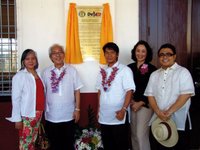 After that anxious wait, the restoration of the Pampanga High School main building, a Gabaldon schoolhouse built in the early 1930s, is finally complete. As always, members of the Heritage Conservation Society trooped to the inauguration and turnover ceremonies. And since this time around, the event was in my own turf, I was the designated driver... hehe! In our group was HCS president Gemma Cruz-Araneta, restoration architects Toti Villalon and Melvin Patawaran, and Carmen Prieto of the Dagupan Heritage Foundation.
After that anxious wait, the restoration of the Pampanga High School main building, a Gabaldon schoolhouse built in the early 1930s, is finally complete. As always, members of the Heritage Conservation Society trooped to the inauguration and turnover ceremonies. And since this time around, the event was in my own turf, I was the designated driver... hehe! In our group was HCS president Gemma Cruz-Araneta, restoration architects Toti Villalon and Melvin Patawaran, and Carmen Prieto of the Dagupan Heritage Foundation.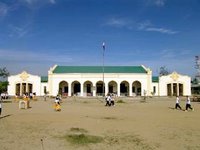 With a current enrollment of 11,000 students, the Pampanga High School is the biggest public high school in Pampanga. Its early roots can be traced back to 1902 when the Americans established the first high school in San Fernando. But due to the lack of students who made it to senior year, students were forced to finish their secondary education elsewhere. So it was not until 1912 that the first class graduated from the Pampanga High School.
With a current enrollment of 11,000 students, the Pampanga High School is the biggest public high school in Pampanga. Its early roots can be traced back to 1902 when the Americans established the first high school in San Fernando. But due to the lack of students who made it to senior year, students were forced to finish their secondary education elsewhere. So it was not until 1912 that the first class graduated from the Pampanga High School.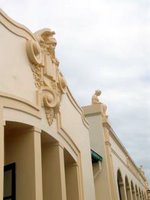 The restored main building is actually the second one since there was an earlier Gabaldon building completed around 1908 together with the Pampanga Capitol building. When the current building was completed in 1935, the older structure was reused as an annex. From 1980 up to 1995, it was used by the University of the Philippines Extension Program in San Fernando, Pampanga. What remains of that historic structure today is a result of the merciless looting and pillaging by some public officials. It stands as a harsh reminder of how badly certain leaders value their own heritage.But even the newer Gabaldon almost became a victim of well-meaning but misinformed efforts of certain indiviuals and groups. Good thing the Department of Education, through Undersecretary Mike Luz, intervened and saved the structure from a merciless renovation, including it in the DepEd-HCS Heritage Schoolhouse Restoration Program.
The restored main building is actually the second one since there was an earlier Gabaldon building completed around 1908 together with the Pampanga Capitol building. When the current building was completed in 1935, the older structure was reused as an annex. From 1980 up to 1995, it was used by the University of the Philippines Extension Program in San Fernando, Pampanga. What remains of that historic structure today is a result of the merciless looting and pillaging by some public officials. It stands as a harsh reminder of how badly certain leaders value their own heritage.But even the newer Gabaldon almost became a victim of well-meaning but misinformed efforts of certain indiviuals and groups. Good thing the Department of Education, through Undersecretary Mike Luz, intervened and saved the structure from a merciless renovation, including it in the DepEd-HCS Heritage Schoolhouse Restoration Program. Today, it stands as a testament to how heritage should and could be conserved. The Pampanga High School itself is a monument to the many leaders it molded, most prominent of which is former president Diosdado P. Macapagal of the Class of 1929. As a young kid, I was already familiarized to this outstanding group since my grandfather, Mariano D. Santos, his sister Felicidad, and their first cousin renowned pre-war journalist Amando G. Dayrit, were all members of the Class of 1929. And my lolo always beamed with pride when he showed us photos of himself together with the former president (my lolo is the one on the left). A sampling of PHS' prominent graduates can be found here.After the program, the group proceeded to Betis and Bacolor to visit their heritage churches. And our visitors were not disappointed. PHS photos courtesy of Arch. Melvin Patawaran.Related articlesPHS alumni, city government clash over heritage building
Today, it stands as a testament to how heritage should and could be conserved. The Pampanga High School itself is a monument to the many leaders it molded, most prominent of which is former president Diosdado P. Macapagal of the Class of 1929. As a young kid, I was already familiarized to this outstanding group since my grandfather, Mariano D. Santos, his sister Felicidad, and their first cousin renowned pre-war journalist Amando G. Dayrit, were all members of the Class of 1929. And my lolo always beamed with pride when he showed us photos of himself together with the former president (my lolo is the one on the left). A sampling of PHS' prominent graduates can be found here.After the program, the group proceeded to Betis and Bacolor to visit their heritage churches. And our visitors were not disappointed. PHS photos courtesy of Arch. Melvin Patawaran.Related articlesPHS alumni, city government clash over heritage building
The HCS meeting at Gota de Leche ended shortly before lunch. And as expected, when there is a large gathering of heritage buffs, an impromptu adventure is in the works. And guess where we decided to go?! Yup, it was a three-in-one afternoon since it was off to three of Manila's historic cemeteries. And we had the best tour guide to take us there, none other than Binondo's street walker and my tokayo Ivan ManDy. With us was Prof. Jojo Mata and Chinatown heritage denizen Jeffrey Yap.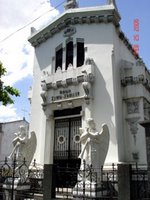 You must be thinking we were all crazy! Why would someone in his right mind visit cemeteries for a leisurely afternoon adventure. Well, the answer is simple... these old cemeteries are the last bastion of Philippine architectural history. They were one of the few areas that were not bombed during the Second World War for obvious reasons which is why the architectural treasures inside were preserved for this generation to see. In fact, a visit to these three cemeteries should be an SOP, a must if I may say so, for any architectural history class since all architectural styles that ever reached Philippine soil from the 1870s to the present are represented in these cities of the dead. From the grand to the whimsical, the numerous mausoleums give today's generation a picture of how rich Philippine architecture was before and shortly after the war. Indeed, this necropolis is a time capsule of Philippine history and culture! Sad to say, my camera is still out of commission, and I had to borrow Ivan ManDy's camera to take shots. There are more but I will have to meet up with him to get the files.
You must be thinking we were all crazy! Why would someone in his right mind visit cemeteries for a leisurely afternoon adventure. Well, the answer is simple... these old cemeteries are the last bastion of Philippine architectural history. They were one of the few areas that were not bombed during the Second World War for obvious reasons which is why the architectural treasures inside were preserved for this generation to see. In fact, a visit to these three cemeteries should be an SOP, a must if I may say so, for any architectural history class since all architectural styles that ever reached Philippine soil from the 1870s to the present are represented in these cities of the dead. From the grand to the whimsical, the numerous mausoleums give today's generation a picture of how rich Philippine architecture was before and shortly after the war. Indeed, this necropolis is a time capsule of Philippine history and culture! Sad to say, my camera is still out of commission, and I had to borrow Ivan ManDy's camera to take shots. There are more but I will have to meet up with him to get the files.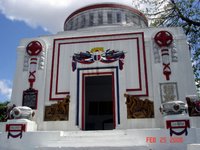 Our first stop was Norte or the Manila North Cemetery. Before the Libingan ng mga Bayani, there was Norte. And that explains the heavy concentration of who's who in Philippine society in it such as revolutionary generals honored in the Mousoleo de los Veteranos de la Revolucion (photo at left) together with other prominent Katipuneros; Philippine presidents Sergio Osmena, Manuel Roxas and Ramon Magsaysay, senators Isauro Gabaldon, Pedro Guevara, Claro M. Recto and Gerry Roxas, House speaker Quintin Paredes, Malolos Congress delegate Benito Legarda, former Manila mayors and other prominent politicians who led our nation during a time when being called a politician was an honor; renowned boxer Pancho Villa; and big names in the arts such as painter Felix Resurrecion Hidalgo, composer Julio Nakpil, architects Arcadio Arellano and Juan Nakpil, and the giants of Philippine cinema which includes Fernando Poe, Sr. and just recently, Fernando Poe, Jr. Prominent foreign citizens can be found here as well including well-loved American governor-general Francis Burton Harrison.
Our first stop was Norte or the Manila North Cemetery. Before the Libingan ng mga Bayani, there was Norte. And that explains the heavy concentration of who's who in Philippine society in it such as revolutionary generals honored in the Mousoleo de los Veteranos de la Revolucion (photo at left) together with other prominent Katipuneros; Philippine presidents Sergio Osmena, Manuel Roxas and Ramon Magsaysay, senators Isauro Gabaldon, Pedro Guevara, Claro M. Recto and Gerry Roxas, House speaker Quintin Paredes, Malolos Congress delegate Benito Legarda, former Manila mayors and other prominent politicians who led our nation during a time when being called a politician was an honor; renowned boxer Pancho Villa; and big names in the arts such as painter Felix Resurrecion Hidalgo, composer Julio Nakpil, architects Arcadio Arellano and Juan Nakpil, and the giants of Philippine cinema which includes Fernando Poe, Sr. and just recently, Fernando Poe, Jr. Prominent foreign citizens can be found here as well including well-loved American governor-general Francis Burton Harrison.
 Each stratum of society was represented, with special plots reserved for certain groups such as the Jewish cemetery, the Masonic burial grounds, the military and police plot, the Thomasites' plot, and that of the twenty boy scouts who died in a 1963 plane crash on their way to the 11th World Jamboree in Greece. Their names are memorialized in a series of streets in Quezon City.The tombs and mausoleums are reminders of an architectural era gone by, designed by the best architects of their time and rendered by top sculptors and builders. From art deco to neo-romanesque and neo-gothic, these monuments stand-out as cultural relics. But Norte is just the tip of the iceberg and our next stop was an even more exciting collection of architecture, a fusion of East and West that results in an ecclectic mix of architectural style and detail only found in the Philippines. And one can never prepare himself for the surprise that beckons at the Chinese Cemetery on a first visit.
Each stratum of society was represented, with special plots reserved for certain groups such as the Jewish cemetery, the Masonic burial grounds, the military and police plot, the Thomasites' plot, and that of the twenty boy scouts who died in a 1963 plane crash on their way to the 11th World Jamboree in Greece. Their names are memorialized in a series of streets in Quezon City.The tombs and mausoleums are reminders of an architectural era gone by, designed by the best architects of their time and rendered by top sculptors and builders. From art deco to neo-romanesque and neo-gothic, these monuments stand-out as cultural relics. But Norte is just the tip of the iceberg and our next stop was an even more exciting collection of architecture, a fusion of East and West that results in an ecclectic mix of architectural style and detail only found in the Philippines. And one can never prepare himself for the surprise that beckons at the Chinese Cemetery on a first visit.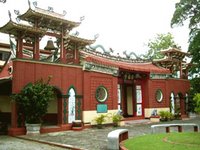 The 54-hectare neighbor of Norte, with areas known as Millionaire's Row and Little Beverly Hills, and temples and monuments to heroes and martyrs as well as grave villas all around, the Chinese Cemetery is a cultural treasure. Indeed I was not prepared for what I was going to see.Cultures mix in every corner, with Buddhist, Confucian and Taoist practices blended in with Catholic tradition. I was surprised to see Catholic images hidden behind Taoist deities at the country's oldest Chinese temple, the Chong Hock Tong temple (photo above left). The group was lucky to see the arrival of a Chinese funeral procession with all its pomp and pageantry. And yet the tolling of the temple bells was distinctly Catholic.
The 54-hectare neighbor of Norte, with areas known as Millionaire's Row and Little Beverly Hills, and temples and monuments to heroes and martyrs as well as grave villas all around, the Chinese Cemetery is a cultural treasure. Indeed I was not prepared for what I was going to see.Cultures mix in every corner, with Buddhist, Confucian and Taoist practices blended in with Catholic tradition. I was surprised to see Catholic images hidden behind Taoist deities at the country's oldest Chinese temple, the Chong Hock Tong temple (photo above left). The group was lucky to see the arrival of a Chinese funeral procession with all its pomp and pageantry. And yet the tolling of the temple bells was distinctly Catholic.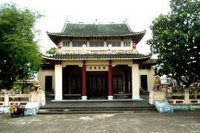 Near the temple were various monuments to war heroes and martyrs. Most imposing of these is the Japanese War Memorial Mausoleum (photo at left), a large hall with photos of ten Chinese community leaders who were executed by the Japanese at the onset of the Second World War. During the Japanese invasion of China in the 1930s, nationalistic passions among the Chinese was very high and these leaders called for a boycott of all Japanese products. Little did they know that the Japanese had them on their watchlist. So when the rising sun arrived in Manila, they were the first to go.Speaking about executions, the cemetery was witness to many of them during WWII. Have you ever wondered who that lady in the 1000-peso bill is? That is Girl Scouts organizer Josefa Llanes Escoda who was martyred in the cemetery. Her name is one in a list of prominent Filipino and Chinese-Filipino citizens martyred in the grounds which includes literary geniuses Rafael Roces and Manuel Arguilla, and Chinese Consul General Yang Guangsheng. Behind the mausoleum are more memorials to war heroes.
Near the temple were various monuments to war heroes and martyrs. Most imposing of these is the Japanese War Memorial Mausoleum (photo at left), a large hall with photos of ten Chinese community leaders who were executed by the Japanese at the onset of the Second World War. During the Japanese invasion of China in the 1930s, nationalistic passions among the Chinese was very high and these leaders called for a boycott of all Japanese products. Little did they know that the Japanese had them on their watchlist. So when the rising sun arrived in Manila, they were the first to go.Speaking about executions, the cemetery was witness to many of them during WWII. Have you ever wondered who that lady in the 1000-peso bill is? That is Girl Scouts organizer Josefa Llanes Escoda who was martyred in the cemetery. Her name is one in a list of prominent Filipino and Chinese-Filipino citizens martyred in the grounds which includes literary geniuses Rafael Roces and Manuel Arguilla, and Chinese Consul General Yang Guangsheng. Behind the mausoleum are more memorials to war heroes.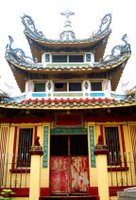
 Moving up and down the alleys and roads of the Chinese Cemetery makes us wonder what ever happened to the architectural savvy of today's Filipino. From burial mounds and traditional Chinese architecture, to East-meets-West fusion architecture that can't be found anywhere else in the world, to sleek Miami-inspired buildings that would get you loco over art deco, the clean and streamlined post-war modernism, the funky 1970s and 1980s post-modernism and today's 21st Century structural modernism, outstanding examples of these styles and even more can be found in the Chinese Cemetery. Size and detail of structures are testaments to the status and wealth of the owners when they were among the living. It is no surprise for example that Chinabank founder Dee C. Chuan had a towering deco edifice for his final resting place (photo 2nd from left).
Moving up and down the alleys and roads of the Chinese Cemetery makes us wonder what ever happened to the architectural savvy of today's Filipino. From burial mounds and traditional Chinese architecture, to East-meets-West fusion architecture that can't be found anywhere else in the world, to sleek Miami-inspired buildings that would get you loco over art deco, the clean and streamlined post-war modernism, the funky 1970s and 1980s post-modernism and today's 21st Century structural modernism, outstanding examples of these styles and even more can be found in the Chinese Cemetery. Size and detail of structures are testaments to the status and wealth of the owners when they were among the living. It is no surprise for example that Chinabank founder Dee C. Chuan had a towering deco edifice for his final resting place (photo 2nd from left).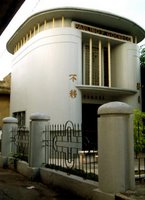 Each mausoleum in the art deco area is a work of genius. Who could miss for example Paulino Go Checo's spaceship deco (photo at left). There also mausoleums of Chinese-Filipino personalities and under this category is that of "mami king" Ma Mon Luk, one of the cemetery's more popular residents. More photos in Ivan ManDy's webshots page.I did hear one trivia about the Chinese Cemetery though... that it is the most expensive piece of real estate in the country! Anyway, one really needs a lot of time to explore the place in detail. Maybe next time since we had one last stop for the afternoon cemetery tour. If Norte is the secular cemetery, the last stop was the main Catholic cemetery of Manila. To cap the day was a visit to the last of the three neighbors, the Campo Santo de la Loma.
Each mausoleum in the art deco area is a work of genius. Who could miss for example Paulino Go Checo's spaceship deco (photo at left). There also mausoleums of Chinese-Filipino personalities and under this category is that of "mami king" Ma Mon Luk, one of the cemetery's more popular residents. More photos in Ivan ManDy's webshots page.I did hear one trivia about the Chinese Cemetery though... that it is the most expensive piece of real estate in the country! Anyway, one really needs a lot of time to explore the place in detail. Maybe next time since we had one last stop for the afternoon cemetery tour. If Norte is the secular cemetery, the last stop was the main Catholic cemetery of Manila. To cap the day was a visit to the last of the three neighbors, the Campo Santo de la Loma. The La Loma Cemetery sits on a hill that bears its name. Near the old entrance is the 19th Century chapel of St. Pancratius (photo at left) which has already been decomissioned with the construction of a modern parish church near the new entrance. The chapel was locked but I was curious what could be found inside. I guess the photos of La Loma can speak for themselves so here is the blog of my tokayo which he has filled with La Loma's architectural works of art.
The La Loma Cemetery sits on a hill that bears its name. Near the old entrance is the 19th Century chapel of St. Pancratius (photo at left) which has already been decomissioned with the construction of a modern parish church near the new entrance. The chapel was locked but I was curious what could be found inside. I guess the photos of La Loma can speak for themselves so here is the blog of my tokayo which he has filled with La Loma's architectural works of art.
Buried within La Loma's walls are more who's who to add to our growing list. I remember seing among others the mausoleums of chief justices Cayetano Arellano (photo below) and Victorino Mapa, and Malolos Congress delegate Pablo Ocampo.
 There are also a lot of prominent Kapampangan families who've chosen this cemetery as their final resting place. There are the Pamintuans of Angeles, the Dayrit y Pamintuan and Salgado clans of San Fernando (revolutionary women Felisa Pamintuan Dayrit and Teodora Salgado-Ulmann are buried in La Loma), and the Alvendia y Guanzon clan of Sta. Rita and Floridablanca. Norte also has Kapampangan families such as the Escaler y Ocampo clan of Apalit and San Fenando. Also in La Loma are the parents and siblings of Rufino Cardinal Santos of Guagua. I was surprised to find members of my own family there, Maria Santos vda. de Pekson (the eldest daughter of my great-great-grandfather Don Mariano Leon Santos y Joven) and her two daughters who both died in a plane crash in 1946. I wonder who visits since they died without children.
There are also a lot of prominent Kapampangan families who've chosen this cemetery as their final resting place. There are the Pamintuans of Angeles, the Dayrit y Pamintuan and Salgado clans of San Fernando (revolutionary women Felisa Pamintuan Dayrit and Teodora Salgado-Ulmann are buried in La Loma), and the Alvendia y Guanzon clan of Sta. Rita and Floridablanca. Norte also has Kapampangan families such as the Escaler y Ocampo clan of Apalit and San Fenando. Also in La Loma are the parents and siblings of Rufino Cardinal Santos of Guagua. I was surprised to find members of my own family there, Maria Santos vda. de Pekson (the eldest daughter of my great-great-grandfather Don Mariano Leon Santos y Joven) and her two daughters who both died in a plane crash in 1946. I wonder who visits since they died without children.
The three cemeteries of La Loma hill should be declared a part of our national heritage. They are repositories of our history, heroes and heritage, and should thus be protected and preserved for future generations of Filipinos. Other cemeteries worth visiting in Metro Manila are the Paco Panteon (now known as Paco Park), the Libingan ng mga Bayani and the Manila American Cemetery and Memorial. Photos of Chinese Cemetery courtesy of Ivan ManDy.
Related articleCemeteries are a time capsule of RP history, culture
 When we say Quiapo, the first things that come to mind are images of the Black Nazarene, the multitude of people that makes an annual walk of fate with the image during the 9th of January processions, and the Basilica Minore of the Black Nazarene (Quiapo Church) with the myriad of hawkers and stalls, herbal medicine and anting-anting vendors and fortune tellers abundant in adjacent Plaza Miranda. But unknown to many, Quiapo is home to an even rarer gem, another basilica minore in fact in Plaza del Carmen. This is the Basilica Minore de San Sebastian, the first all-steel church in the Philippines and in Asia, and the second in the world.
When we say Quiapo, the first things that come to mind are images of the Black Nazarene, the multitude of people that makes an annual walk of fate with the image during the 9th of January processions, and the Basilica Minore of the Black Nazarene (Quiapo Church) with the myriad of hawkers and stalls, herbal medicine and anting-anting vendors and fortune tellers abundant in adjacent Plaza Miranda. But unknown to many, Quiapo is home to an even rarer gem, another basilica minore in fact in Plaza del Carmen. This is the Basilica Minore de San Sebastian, the first all-steel church in the Philippines and in Asia, and the second in the world. It was sometime in 1995 or 1996, my third year in the Ateneo and we were the beneficiaries of the first-ever alternative class day called KLIK... Klaseng Ibang Klase. We had a choice of selecting three talks throughout the day or pick a day trip for a fee. And I chose this trip to old Manila, with social studies teacher Estela Banasihan and Fr. Mac Reyes, S.J. as tour guides. I consider this trip my introduction to Philippine architectural heritage. The trip tickled my fancy in fact that the next year, I chose another heritage tour during KLIK, a church tour in Rizal and Laguna.
It was sometime in 1995 or 1996, my third year in the Ateneo and we were the beneficiaries of the first-ever alternative class day called KLIK... Klaseng Ibang Klase. We had a choice of selecting three talks throughout the day or pick a day trip for a fee. And I chose this trip to old Manila, with social studies teacher Estela Banasihan and Fr. Mac Reyes, S.J. as tour guides. I consider this trip my introduction to Philippine architectural heritage. The trip tickled my fancy in fact that the next year, I chose another heritage tour during KLIK, a church tour in Rizal and Laguna. One of our stops was the San Sebastian Church. And to tell you honestly, I was not ready for what I was going to see. Upon entering, this young high school student never realized that such a treasure existed in the country. And I remember distinctly Fr. Mac knocking on the walls of the church to prove to us that the structure was indeed made of steel!
One of our stops was the San Sebastian Church. And to tell you honestly, I was not ready for what I was going to see. Upon entering, this young high school student never realized that such a treasure existed in the country. And I remember distinctly Fr. Mac knocking on the walls of the church to prove to us that the structure was indeed made of steel! I would later find out that the Philippines used to have much more than that. But the very structures which made us the Pearl of the Orient, architectural treasures that spanned hundreds of years, were flattened by the American Army in a few days during the liberation of Manila.
I would later find out that the Philippines used to have much more than that. But the very structures which made us the Pearl of the Orient, architectural treasures that spanned hundreds of years, were flattened by the American Army in a few days during the liberation of Manila.
 This is why the World Monuments Fund (WMF) included the structure in the List of 100 Most Endangered Sites in 1998. Inclusion in the World Monuments Watch entitles the structure to grants for restoration. And I find it stupid that the custodians of the church rejected the $25,000 grant given by the WMF simply because of jurisdiction issues with the Philippine government. As a result, the Philippines had to do the embarrassing act of returning the $25,000 to the WMF!
This is why the World Monuments Fund (WMF) included the structure in the List of 100 Most Endangered Sites in 1998. Inclusion in the World Monuments Watch entitles the structure to grants for restoration. And I find it stupid that the custodians of the church rejected the $25,000 grant given by the WMF simply because of jurisdiction issues with the Philippine government. As a result, the Philippines had to do the embarrassing act of returning the $25,000 to the WMF!

















